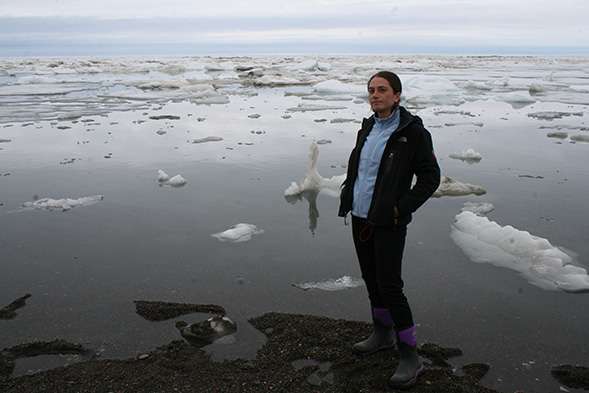Biologist comments on a startling new finding in climate change research

The steady march of global warming over the past century has led to the thawing of permafrost—a layer of subsurface soil in the Arctic that usually remains frozen year-round. While that's troubling for local ecosystems, it could have disastrous global impacts as well. As this permafrost melts, it sets off a biochemical chain reaction in the soil that could dramatically increase the emission of greenhouse gases into the atmosphere, accelerating further climate change. San Diego State University biologist Donatella Zona wrote about this issue in a commentary article this week in the journal Nature.
In her commentary, she provides expert perspective on recent findings published in the journal Biogeosciences by Min Jung Kwon of the Max Planck Institute for Biogeochemistry in Jena, Germany. Kwon and her team report that the layer of permafrost typically acts as a barrier against moisture drainage in the soil. As this permafrost melts, the moisture drains out, leaving the top layers of the soil drier and warmer. This warming kick-starts a biochemical process within organic matter present in the soil that releases carbon dioxide into the atmosphere. Atmospheric carbon dioxide and other greenhouse gases are leading contributors to warming global temperatures.
"The authors report that the net effect of draining in their study is an increase in the amount of CO2 emitted to the atmosphere, which will ultimately magnify climate change," Zona wrote in her commentary.
Zona published a study about the effects of drainage in permafrost earlier this year in the journal Nature Geoscience. Additionally, she and fellow SDSU ecologist Walt Oechel, along with colleagues at several other institutions, published another study last year showing that the emission of methane, another greenhouse gas, is highest in the Arctic during the region's cold season. That was surprising, as most scientists thought little if any greenhouse gases escaped the frozen soil during the cold season.
Sure enough, Kwon's recent study shows a similar trend for carbon dioxide.
"Importantly, Kwon and colleagues show the increase is highest during the cold season, a notoriously under-studied part of the year in tundra ecosystems," Zona wrote.
More data is needed to better understand the long-term implications of these findings on larger climate change patterns, Zona said. But that's difficult, as funding for such studies is scarce.
"Unfortunately, given the costs of doing research in this region, funding agencies tend to support projects of only 3–5 years—hardly long enough to provide even a first glimpse of the impact of climate change," she wrote. "Long-term studies would be possible only through a collaboration of research groups, with several funding agencies sharing the financial burden."
More information: Donatella Zona. Biogeochemistry: Long-term effects of permafrost thaw, Nature (2016). DOI: 10.1038/537625a
Min Jung Kwon et al. Long-term drainage reduces CO2 uptake and increases CO2 emission on a Siberian floodplain due to shifts in vegetation community and soil thermal characteristics, Biogeosciences (2016). DOI: 10.5194/bg-13-4219-2016
Anna K. Liljedahl et al. Pan-Arctic ice-wedge degradation in warming permafrost and its influence on tundra hydrology, Nature Geoscience (2016). DOI: 10.1038/ngeo2674
Journal information: Nature , Biogeosciences , Nature Geoscience
Provided by San Diego State University





















